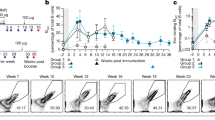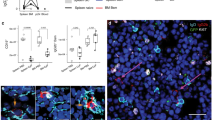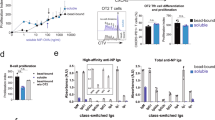Abstract
The basis of immune memory leading to heightened secondary antibody responses is a longstanding unanswered issue. Here we show that a single irreversible molecular change in the B cell antigen receptor, which is brought about by immunoglobulin M (IgM) to IgG isotype switching, is sufficient to greatly increase the extrafollicular proliferative burst of antigen-specific B cells. The unique membrane-spanning regions of IgG do not alter the T cell–dependent activation and proliferation of antigen-specific B cells in vivo, but markedly increase the number of progeny cells and plasmablasts that accumulate. These results establish a key molecular determinant of immunological memory and define an unexpected cellular basis by which it enhances the magnitude of secondary antibody responses.
This is a preview of subscription content, access via your institution
Access options
Subscribe to this journal
Receive 12 print issues and online access
$209.00 per year
only $17.42 per issue
Buy this article
- Purchase on Springer Link
- Instant access to full article PDF
Prices may be subject to local taxes which are calculated during checkout







Similar content being viewed by others
References
Dixon, F. J., Maurer, P. H. & Deichmiller, M. P. Primary and specific anamnestic antibody responses of rabbits to heterologous serum protein antigens. J. Immunol. 72, 179–186 (1954).
Ahmed, R. & Gray, D. Immunological memory and protective immunity: Understanding their relation. Science 272, 54–60 (1996).
Celada, F. The cellular basis of immunologic memory. Progr. Allergy 15, 223–267 (1971).
Gray, D. Immunological memory. Annu. Rev. Immunol. 11, 49–77 (1993).
Sprent, J. T & B memory cells. Cell 76, 315–322 (1994).
Hayakawa, K., Ishii, R., Yamasaki, K., Kishimoto, T. & Hardy, R. R. Isolation of high-affinity memory B cells: Phycoerythrin as a probe for antigen-binding cells. Proc. Natl Acad. Sci. USA 84, 1379–1383 (1987).
Shittek, B. & Rajewsky, K. Maintenance of B-cell memory by long-lived cells generated from proliferating precursors. Nature 346, 749–751 (1990).
Eisen, H. N. & Siskind, G. W. Variations in affinities of antibodies during the immune response. Biochemistry 3, 996–1007 (1964).
Weiss, U. & Rajewsky, K. The repertoire of somatic antibody mutants accumulating in the memory compartment after primary immunization is restricted through affinity maturation and mirrors that expressed in the secondary response. J. Exp. Med. 172, 1681–1689 (1990).
Klein, U., Rajewsky, K. & Kuppers, R. Human immunoglobulin (Ig)M+IgD+ peripheral blood B cells expressing the CD27 cell surface antigen carry somatically mutated variable region genes: CD27 as a general marker for somatically mutated (memory) B cells. J. Exp. Med. 188, 1679–1689 (1998).
Tangye, S. G., Liu, Y. J., Aversa, G., Phillips, J. H. & de Vries, J. E. Identification of functional human splenic memory B cells by expression of CD148 and CD27. J. Exp. Med. 188, 1691–1703 (1998).
Liu, Y. J. et al. Memory B cells from human tonsils colonize mucosal epithelium and directly present antigen to T cells by rapid up-regulation of B7-1 and B7-2. Immunity 2, 239–248 (1995).
Liu, Y. J., Zhang, J., Lane, P. J. L., Chan, E. Y.-T. & MacLennan, I. C. M. Sites of specific B cell activation in primary and secondary responses to T cell-dependent and T cell-independent antigens. Eur. J. Immunol. 21, 2951–2962 (1991).
Tierens, A., Delabie, J., Michiels, L., Vandenberghe, P. & De Wolf-Peeters, C. Marginal-zone B cells in the human lymph node and spleen show somatic hypermutations and display clonal expansion. Blood 93, 226–234 (1999).
Maruyama, M., Lam, K. & Rajewsky, K. Memory B cell persistence is independent of persisting immunizing antigen. Nature 407, 636–642 (2000).
Reth, M. Antigen receptors on B lymphocytes. Annu. Rev. Immunol. 10, 97–121 (1992).
Nussenzweig, M. C. Immune responses: tails to teach a B cell. Curr. Biol. 7, 355–357 (1997).
Weiser, P., Riesterer, C. & Reth, M. The internalization of the IgG2a antigen receptor does not require the association with Ig-α/Ig-β but the activation of protein tyrosine kinases doses. Eur. J. Immunol. 24, 665–671 (1994).
Knight, A. M., Lucocq, J. M., Prescott, A. R., Ponnanbalam, S. & Watts, C. Antigen endocytosis and presentation mediated by human membrane IgG1 in the absence of the Igα/Igβ dimer. EMBO J. 16, 3842–3850 (1997).
Kaisho, T., Schwenk, F. & Rajewsky, K. The roles of gamma 1 heavy chain membrane expression and cytoplasmic tail in IgG1 responses. Science 276, 412–415 (1997).
Achatz, G., Nitschke, L. & Lamers, M. C. Effect of transmembrane and cytoplasmic domains of IgE on the IgE response. Science 276, 409–411 (1997).
Brink, R. et al. Immunoglobulin M and D antigen receptors are both capable of mediating B lymphocyte activation, deletion, or anergy after interaction with specific antigen. J. Exp. Med. 176, 991–1005 (1992).
Goodnow, C. C. et al. Altered immunoglobulin expression and functional silencing of self-reactive B lymphocytes in transgenic mice. Nature 334, 676–682 (1988).
Pogue, S. L. & Goodnow, C. C. Gene dose-dependent maturation and receptor editing of B cells expressing immunoglobulin (Ig)G1 or IgM/IgG1 tail antigen receptors. J. Exp. Med. 191, 1031–1044 (2000).
Ho, W. Y., Cooke, M. P., Goodnow, C. C. & Davis, M. M. Resting and anergic B cells are defective in CD28-dependent co-stimulation of naive CD4+ T cells. J. Exp. Med. 179, 1539–1549 (1994).
Pogue, S. L. & Goodnow, C. C. Ig heavy chain extracellular spacer confers unique glycosylation of the Mb-1 component of the B cell antigen receptor complex. J. Immunol. 152, 3925–3934 (1994).
Lyons, A. B. & Parish, C. R. Determination of lymphocyte division by flow cytometry. J. Immunol. Meth. 171, 131–137 (1994).
Sze, D. M.-Y., Toellner, K.-M., Garcìa de Vinuesa, C., Taylor, D. R. & MacLennan, I. C. M. Intrinsic constraint on plasmablast growth and extrinsic limits of plasma cell survival. J. Exp. Med. 192, 813–821 (2000).
Burnet, F. M. The clonal selection theory of acquired immunity (Cambridge University Press, London, 1959).
Coffman, R. L. & Cohn, M. The class of surface immunoglobulin on virgin and memory B lymphocytes. J. Immunol. 118, 1806–1815 (1977).
Yuan, D., Vitetta, E. S. & Kettman, J. R. Cell surface immunoglobulin. XX. Antibody responsiveness of subpopulations of B lymphocytes bearing different isotypes. J. Exp. Med. 145, 1421–1435 (1977).
Yefenof, E., Sanders, V. M., Uhr, J. W. & Vitetta, E. S. In vitro activation of murine antigen-specific memory B cells by a T-dependent antigen. J. Immunol. 137, 85–90 (1986).
Toellner, K.-M., Gulbranson-Judge, A., Taylor, D. R., Sze, D. M.-Y. & MacLennan, I. C. M. Immunoglobulin switch transcript production in vivo related to the site and time of antigen-specific B cell activation. J. Exp. Med. 183, 2303–2312 (1996).
Vora, K. A., Tumas-Brundage, K. M. & Manser, T. A periarteriolar lymphoid sheath-associated B cell focus response is not observed during the development of the anti-arsonate germinal center reaction. J. Immunol. 160, 728–733 (1998).
Arpin, C., Banchereau, J. & Liu, Y. J. Memory B cells are biased towards terminal differentiation: a strategy that may prevent repertoire freezing. J. Exp. Med. 186, 931–940 (1997).
Doyle, A. M. et al. Induction of cytotoxic T lymphocyte antigen 4 (CTLA-4) restricts clonal expansion of helper T cells. J. Exp. Med. 194, 893–902 (2001).
Gudmundsdottir, H., Wells, A. D. & Turka, L. A. Dynamics and requirements of T cell clonal expansion in vivo at the single-cell level: effector function is linked to proliferative capacity. J. Immunol. 162, 5212–5223 (1999).
Hill, S. W. & Sercarz, E. E. Fine specificity of the H-2 linked immune response gene for the gallinaceous lysozymes. Eur. J. Immunol. 5, 317–324 (1975).
Warren, H. S. Using carboxyfluorescein diacetate succinimidyl ester to monitor human NK cell division: Analysis of the effect of activating and inhibitory class I MHC receptors. Immunol. Cell Biol. 77, 554–551 (1999).
Rathmell, J. C. & Goodnow, C. C. Effects of the lpr mutation on elimination and inactivation of self-reactive B cells. J. Immunol. 153, 2831–42 (1994).
Goodnow, C. C., Crosbie, J., Jorgensen, H., Brink, R. A. & Basten, A. Induction of self-tolerance in mature peripheral B lymphocytes. Nature 342, 385–391 (1989).
Mason, D. Y., Jones, M. & Goodnow, C. C. Development and follicular localization of tolerant B lymphocytes in lysozyme/anti-lysozyme IgM/IgD transgenic mice. Int. Immunol. 4, 163–175 (1992).
Acknowledgements
We thank K. Sullivan and the staff of the Medical Genome Centre for expert care and breeding of the transgenic mice and L. Wilson and A. Murtagh for expert genotyping.
Author information
Authors and Affiliations
Corresponding author
Ethics declarations
Competing interests
The authors declare no competing financial interests.
Supplementary information
Web Figure 1.
Construct information and membrane tail BCR sequence from the various anti-HEL Ig–Tg lines used. Information is taken from descriptions of the MD423; MM422; MG2, MG6 and GG424 Tg lines and from a description of the constructs used to produce the MδE1 and MδE2 Tg lines26. LVDJ, rearranged variable region genes from the antiHEL hybridoma HyHEL10; Eμ, μ intronic enhancer; SR μ, intact μ switch region; SR μ*, μ switch region carrying a 2.8-kb internal deletion; SR μ/g, hybrid switch region between μ and g. Dashes indicate sequence identity with the μ Hc. (GIF 31 kb)
Rights and permissions
About this article
Cite this article
Martin, S., Goodnow, C. Burst-enhancing role of the IgG membrane tail as a molecular determinant of memory. Nat Immunol 3, 182–188 (2002). https://doi.org/10.1038/ni752
Received:
Accepted:
Published:
Issue Date:
DOI: https://doi.org/10.1038/ni752
This article is cited by
-
A cold-blooded view of adaptive immunity
Nature Reviews Immunology (2018)
-
Naïve and memory B cells exhibit distinct biochemical responses following BCR engagement
Immunology & Cell Biology (2016)
-
Memory B cells
Nature Reviews Immunology (2015)
-
Acidic phospholipids govern the enhanced activation of IgG-B cell receptor
Nature Communications (2015)
-
Reactivation of IgG-switched memory B cells by BCR-intrinsic signal amplification promotes IgG antibody production
Nature Communications (2015)



